Finding Wonder in Textile Waste
Cliché but true: One man's trash is another man's treasure.
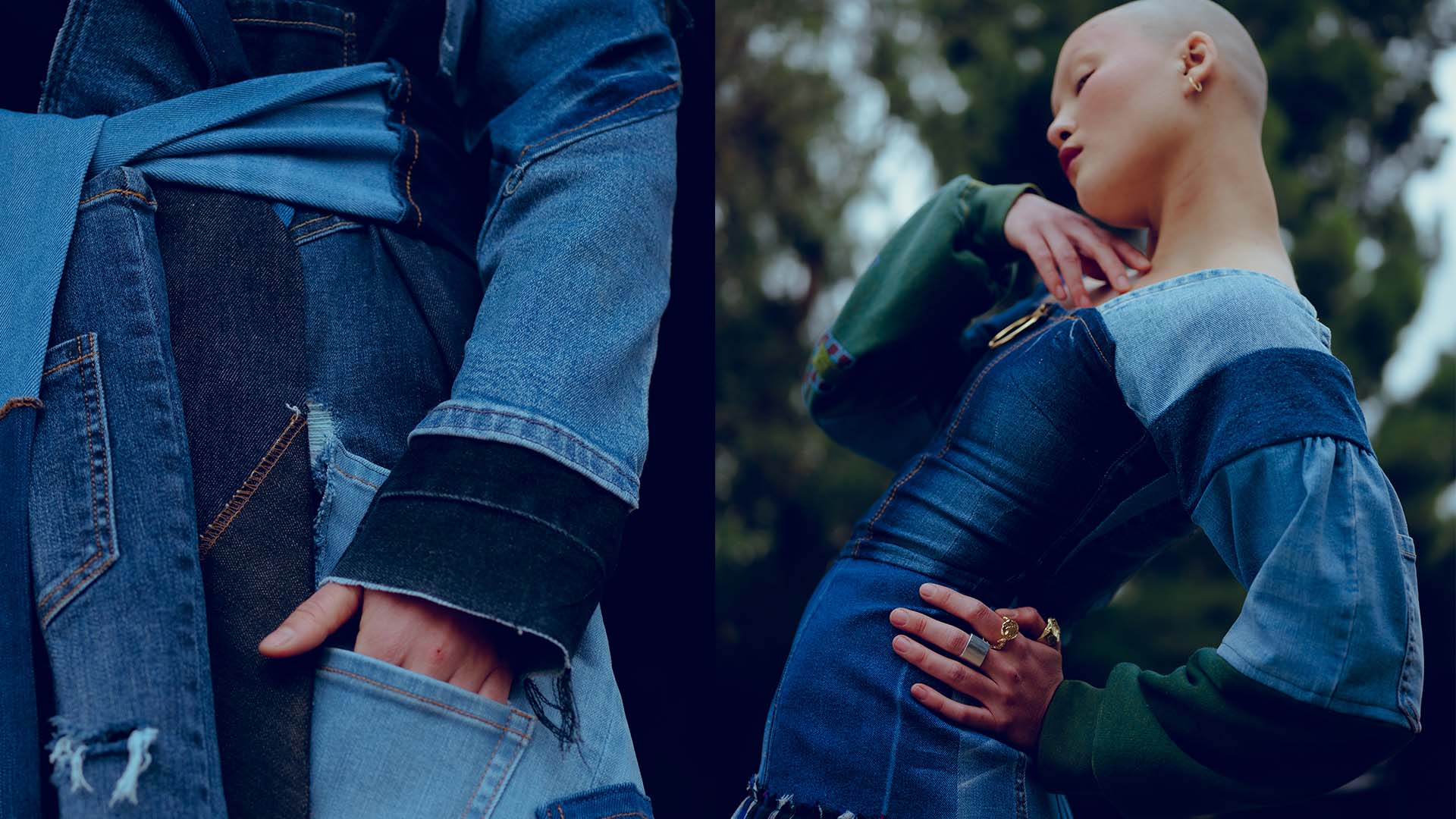
A job at the New York City Department of Sanitation is an unlikely entry point to a career in fashion, but for Jessica Schreiber, that’s where the seeds of her textile non-profit were planted. While overseeing the city’s clothing and e-waste recycling programs, Schreiber saw firsthand how much fabric was being treated as trash. While some materials qualified for the initiatives, there were still items that fell through the cracks: “Several brands reached out to me and said, ‘Well, we have textile waste but it’s not clothing. It’s fabric swatches, extra zippers, sample garments, and more,’” she says.
With a little ingenuity, these bits can have a second life, Schreiber realized. In 2016, she started FabScrap, a non-profit that gathers up leftovers from the likes of Marc Jacobs, Oscar de la Renta, and Carolina Herrera. What normally qualifies as waste is instead high quality materials for fashion students and enthusiasts alike to use for their creations. With a location in the Brooklyn Army Terminal Navy Yard and a brisk online business (prices begin at $3 per yard; with a pay-what-you-wish option for certain styles as well), FabScrap has diverted more than 950,000 pounds of fabric away from landfills in five years.
One material that often winds up at Schreiber’s non-profit is denim—notorious for its huge environmental impact, from the cotton growing process to the dye and chemical runoff to the excessive water usage. Despite its ugly reputation, could something beautiful and luxurious result from these neglected denim scraps? Marie Claire challenged five sustainably-minded designers to take a 10-pound box of assorted scraps and transform them into a garment that’s stylish and good for the environment. The ultimate goal: To not only change the material into something new, but to shift consumers’ minds, as well, so that they “think of waste as a resource,” says Schreiber, “and look for the brands that are willing to take on the responsibility for their own waste as well.”
Below, what each designer created with their discarded denim.
Selina Sanders: A Flouncy Dress Made for Movement
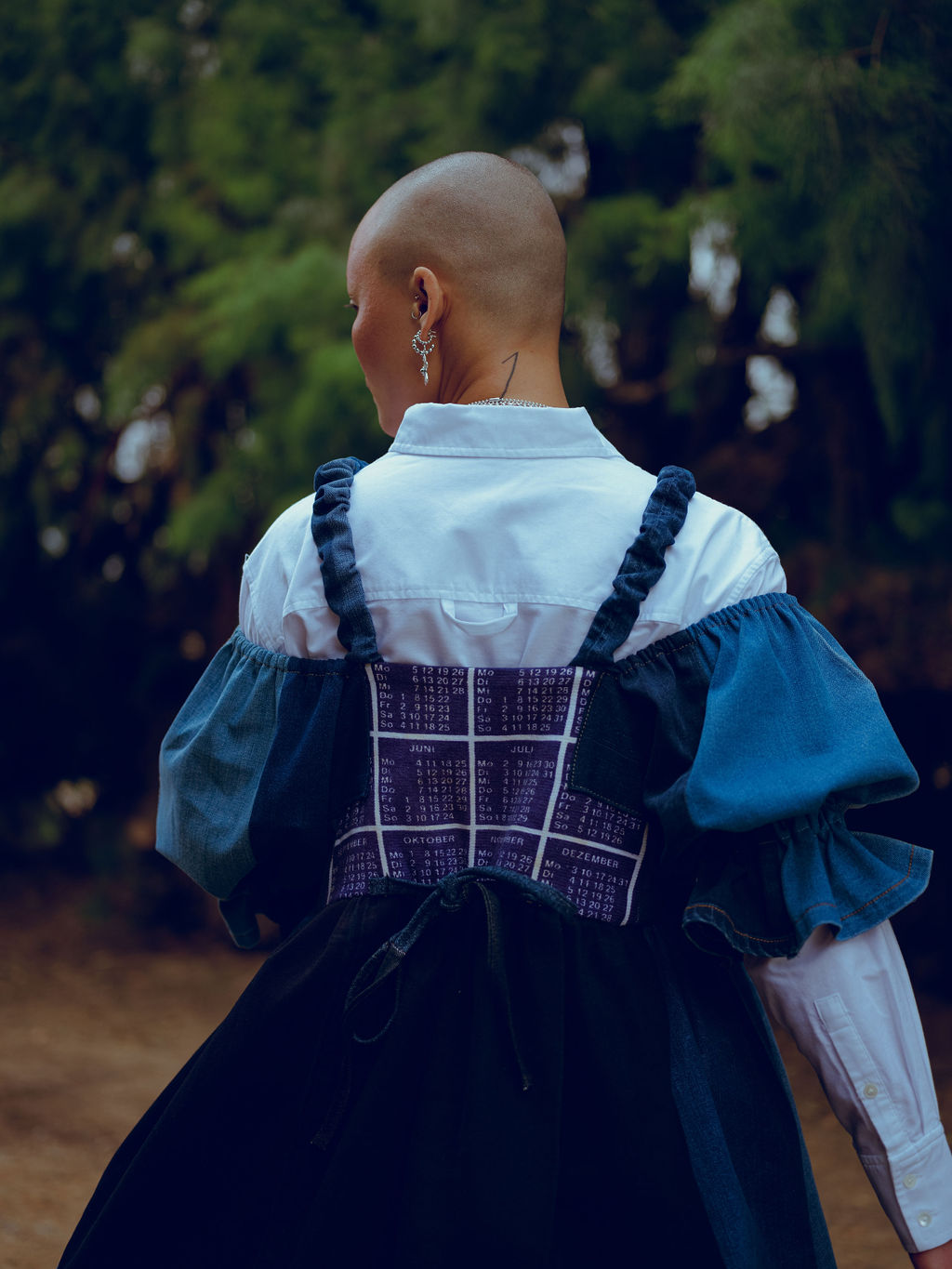
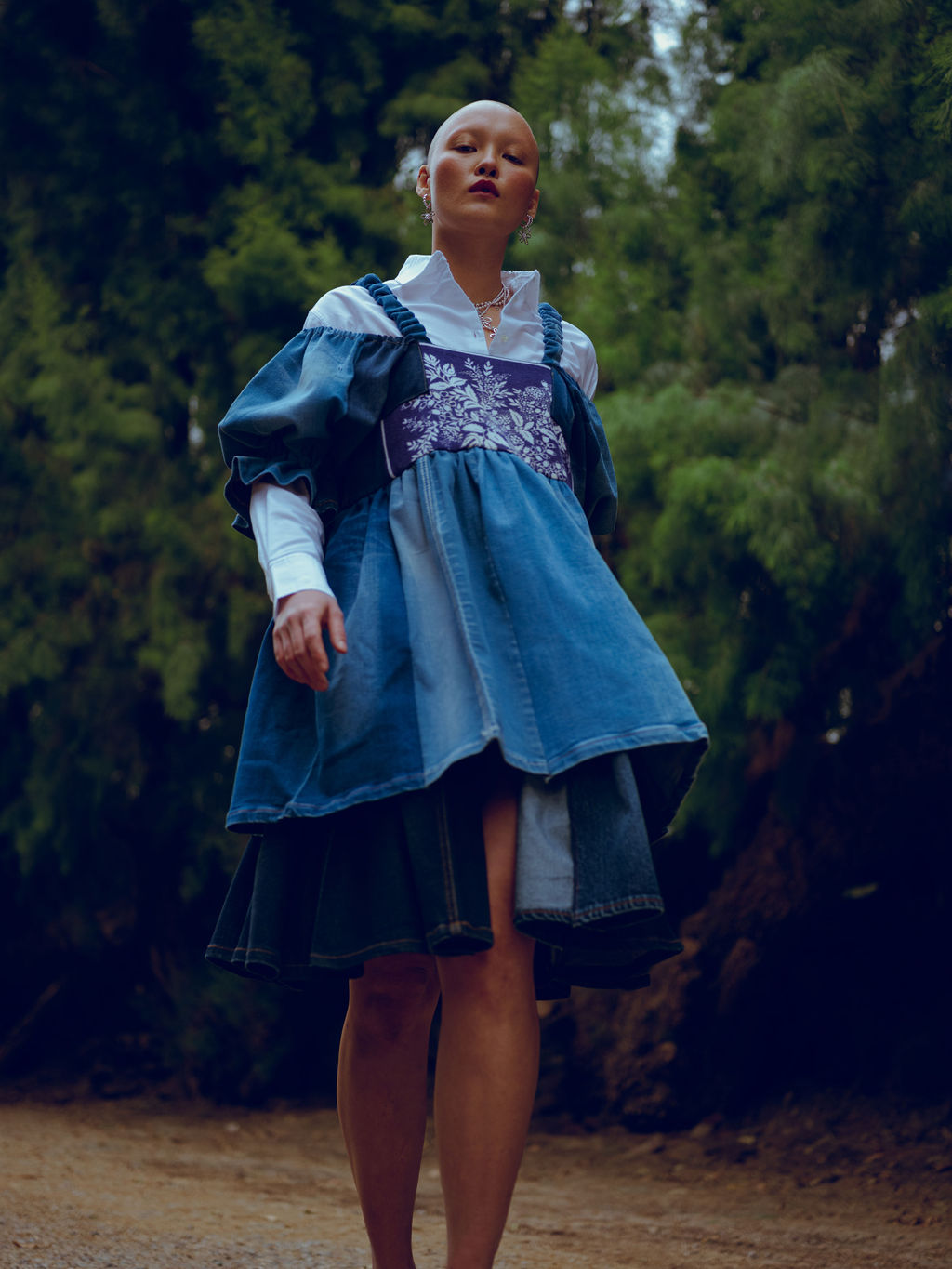
Working in the fashion industry as a designer for the likes of Target, St. John Knits, and BCBG Max Azria for more than 15 years, Selina Sanders saw how much fabric waste was generated on a regular basis. She was pleasantly surprised to find pieces that are normally discarded in her FabScrap box: “These denim ‘legs’ are what factories use as a reference to help a designer decide on a wash,” she says of her starting material. “I imagine so many of these are produced yearly and I’m glad we could make them into something more desirable.”
Sanders, who was born and raised in the Philippines before moving to America as a teenager, started her eponymous label during the pandemic by happenstance. Inspired by a hashtag from YouTuber Beth Jones that encouraged dressing up even during lockdown, Sanders played around with fabric she had at home to make something fancy. Her first creation, a puffy sleeved blouse made from a tea towel and a quilt, was posted by Jones.
Suddenly the Altadena, California–based designer found herself with a giant fanbase eager to buy her tops. Since then, she has expanded her line to dresses, skirts, and more, but they remain in limited quantities due to her use of one-of-a-kind vintage tea towels, which serve as the base and inspiration for each piece.
Stay In The Know
Get exclusive access to fashion and beauty trends, hot-off-the-press celebrity news, and more.
Her process for this challenge began with hunting down the right towels—navy blue with a white botanical motif for the front and a calendar for the back. “[The former] complemented the denim and became the focal point of the dress,” she says. From there, she added the flourishes she’s known for, namely poofy sleeves and a full skirt, using various gradations of denim. “I loved that the different washes could be used in a way to create a piece that looked different in the front or back,” Sanders says of the process, which felt like a big puzzle. She describes the work as old-school, ripping and resewing seams for her creation. “My design mantra is ‘Maximum Style; Minimal Carbon Footprint’, and there's nothing more fun than a full skirt that bounces when you walk or dance.” Fun and upcycled? Seems like a great way to kick off 2022.
Asata Maisé: An Avant Garde Trench
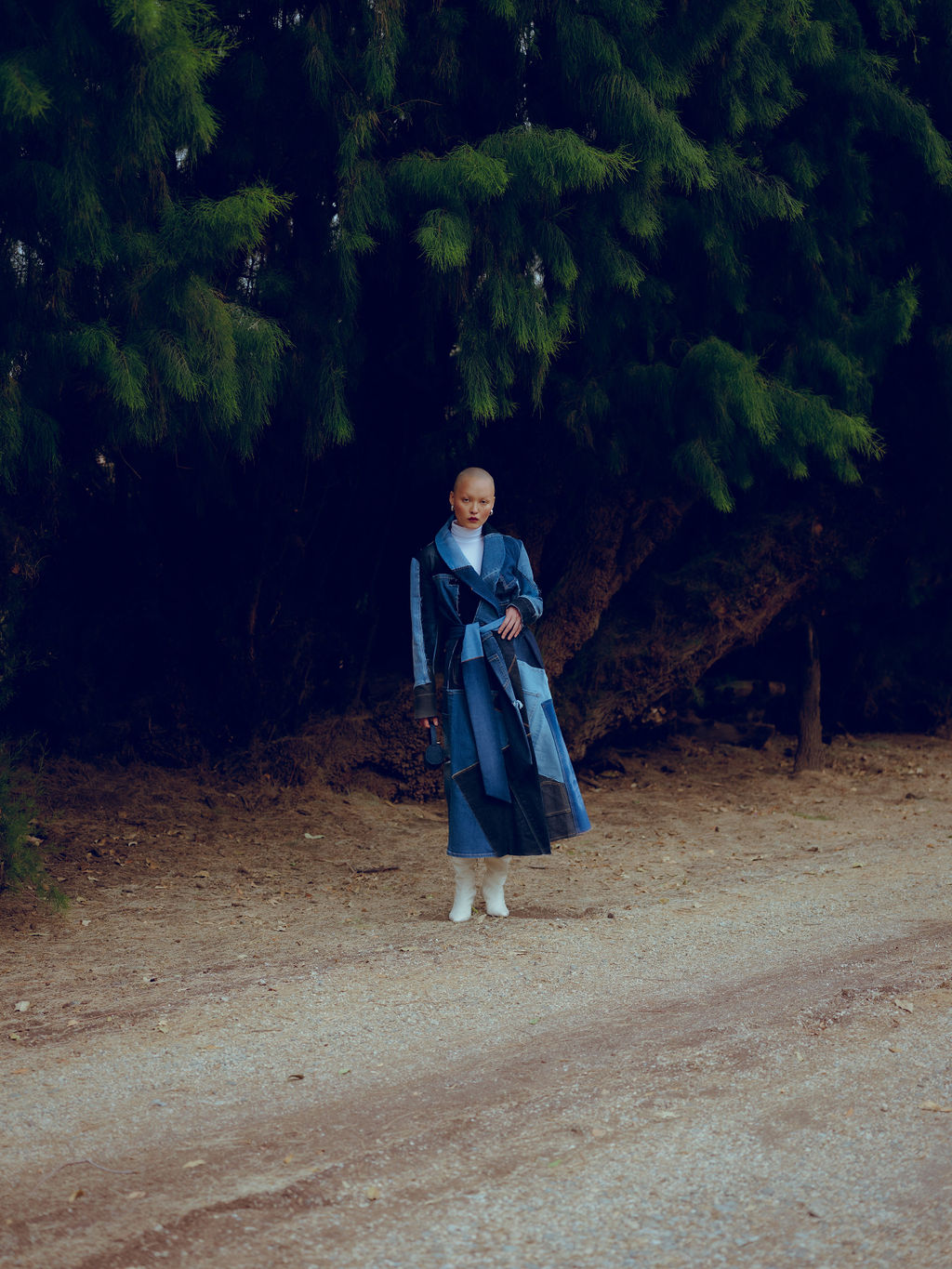
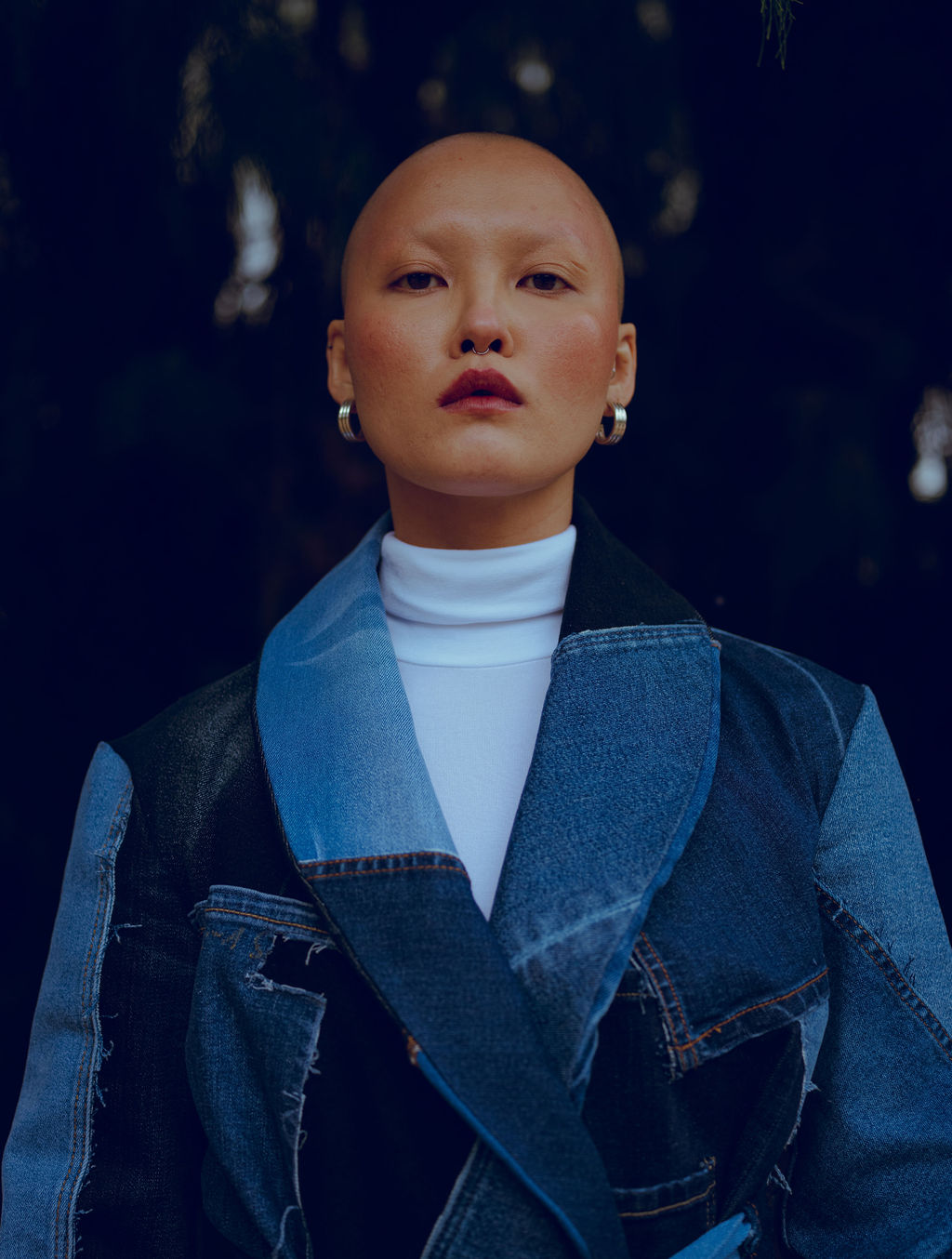
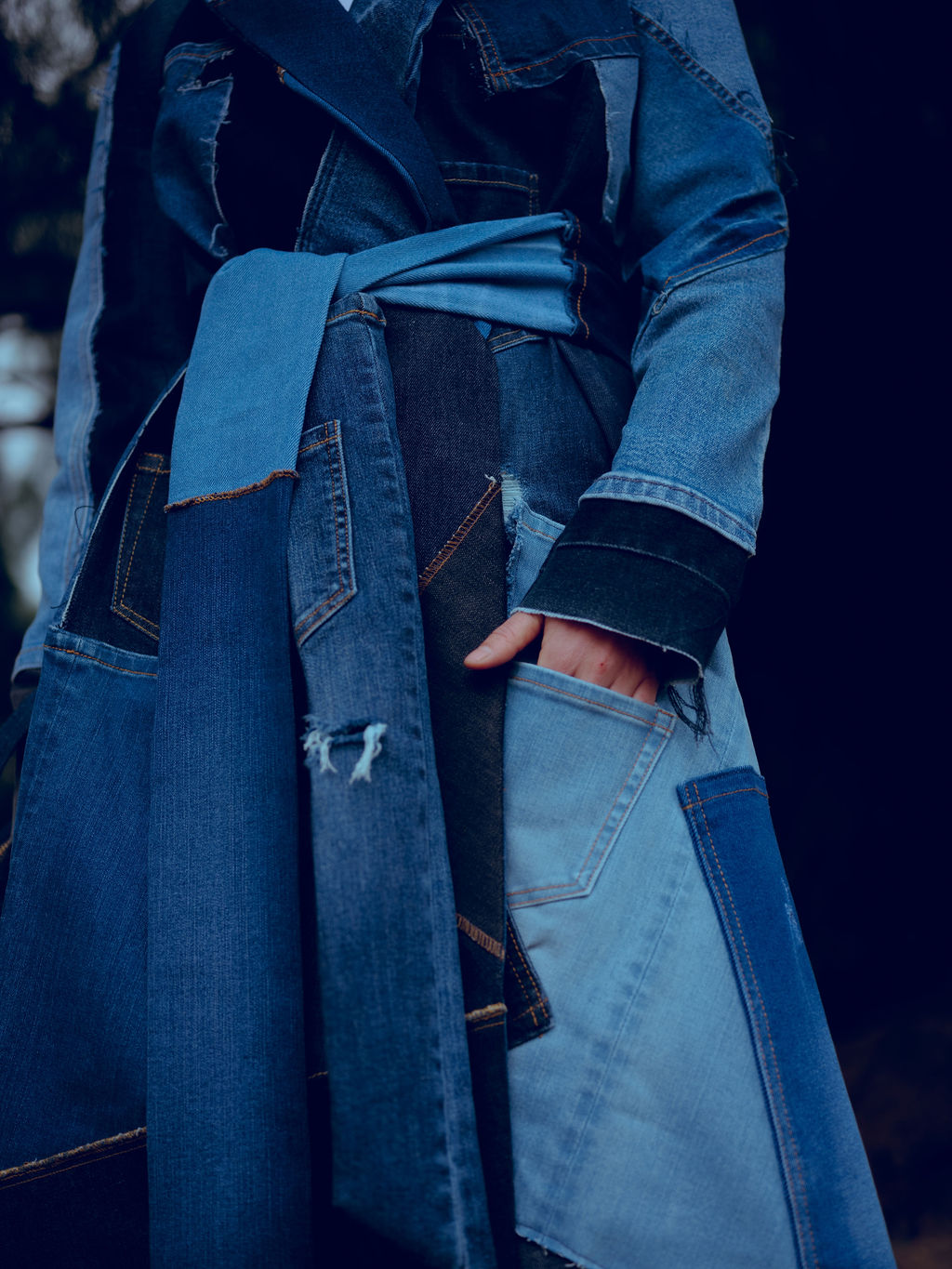
For Asata Maisé, making clothes is a spiritual experience. She describes her work as deeply emotional, inviting her customers to experience her collection through curated playlists that offer insight into her state of mind as she designs and creates. Her namesake brand centers on handmade styles and slow fashion, with an emphasis on using deadstock fabric. Maisé is best known for her patchwork '90s-style handbags that became a pandemic-era success, selling out in hours. Her line also includes ready-to-wear and accessories like bucket hats.
The designer knew from an early age that she was interested in creative pursuits. In high school, Maisé took a textiles course and her teacher recognized her abilities, encouraging her to pursue bigger ambitions. Following stints at Michael Costello and Diane von Furstenberg, Maisé moved home to Delaware at the end of 2019 to create her own brand. The pandemic upended Maisé’s plans and it wasn’t until she applied for Halsey’s Black Creators Funding Initiative (and placed in the top five), that she was able to invest in growing her business.
Maisé decided to approach her box of scraps with something familiar in mind: a trench coat design she had made in the past, albeit with a twist. “I recently watched Martin Margiela: In His Own Words and I was inspired to use the fabric pieces in a way I think Martin Margiela would have,” she says. That meant creating an exaggerated version of her signature patchwork aesthetic with unfinished edges, a nod to Margiela’s preference for minimalist and deconstructed avant garde designs. “I wanted this piece to look and feel very organic,” she explains. But that doesn’t mean unapproachable. “I also wanted to highlight the fact that anyone can upcycle what already exists with some thread and a sewing machine,” she explains. “I hope this inspires anyone to get creative with their own methods of repurposing.”
Denimcratic: A Y2K Throwback Set
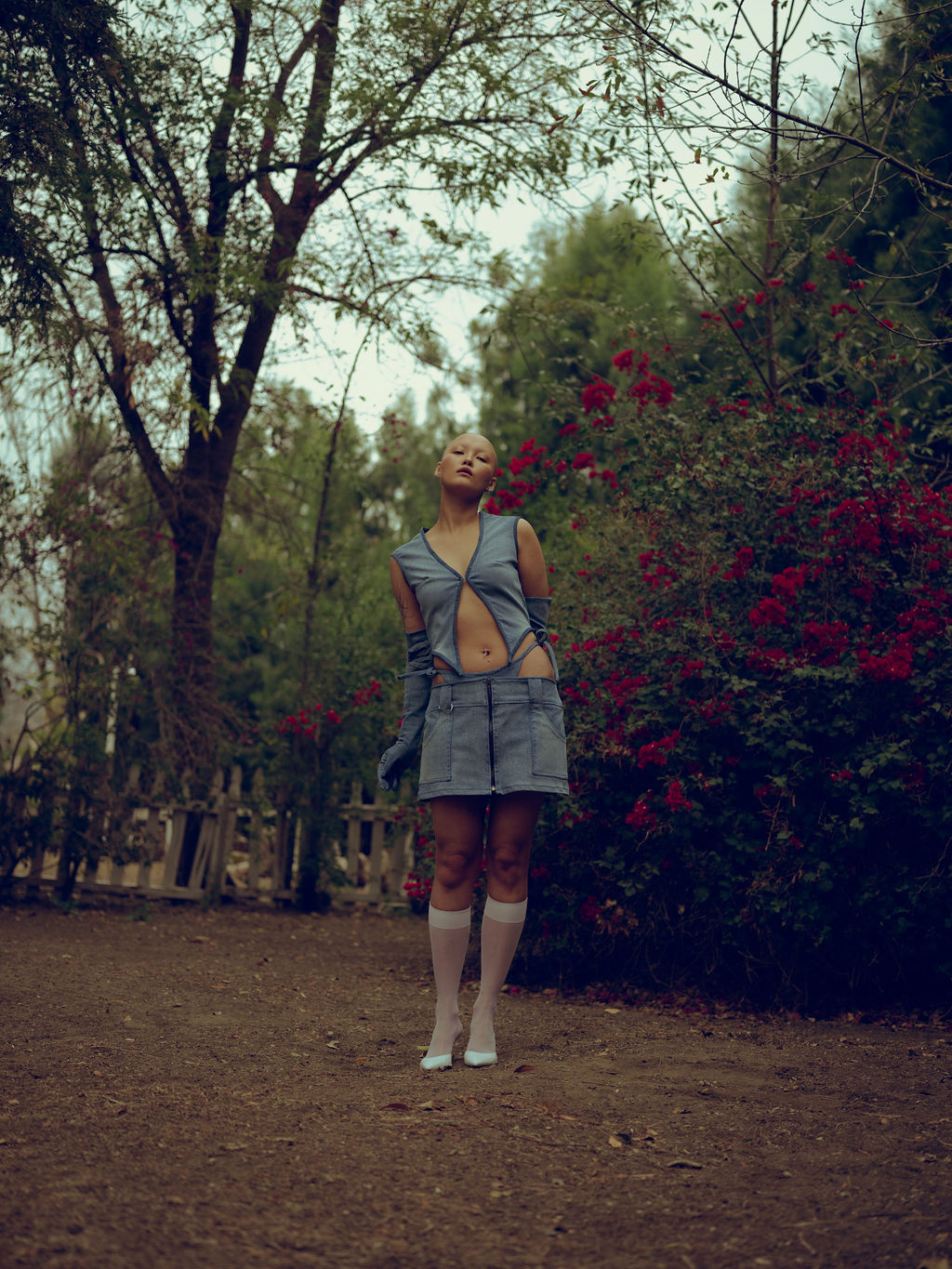
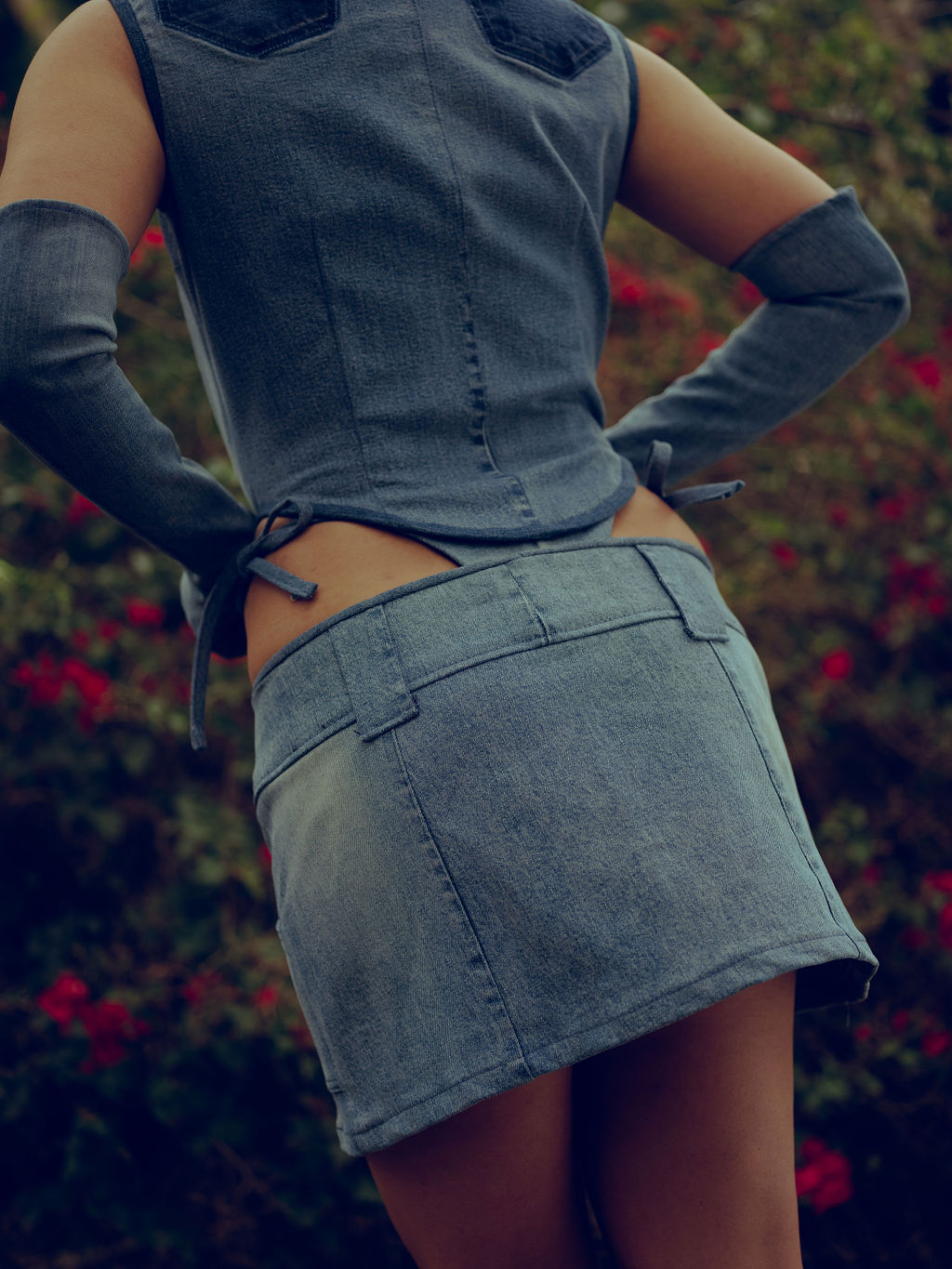
The early aughts are back, and Denimcratic designer Gabriella Meyer is a fan of the revival. “That time was most definitely a golden age for denim, and I wanted to use this opportunity to celebrate that moment in history,” she says of her inspiration.
Founded in 2017, Meyer’s Los Angeles–based brand doesn’t shy away from big statements. Meyer first garnered attention with her political work, laser engraving clothing with reports of sexual harassment in the workplace. Since then, she’s tackled issues like getting out the vote and climate change. Using a mix of upcycled denim, tees, and sweaters, Denimcratic features Gen Z–friendly pieces in bold colors and slinky silhouettes that bare plenty of skin.
That aesthetic holds here. Meyer took her denim scraps and created a butterfly top, thong, and miniskirt that look as though they came straight out of Britney Spears’s closet circa 2003. “This piece was created in a traditional cut and sew operation,” she says of her method. “With some of our garments we do utilize laser engraving to create our own textile patterns; it's a great way to achieve detailed graphics on the denim without using any additives like ink or bleach,” she adds. In this case, however, she kept the focus on the recognizable early-aughts silhouettes.
As flashy as these pieces may be, Meyer’s design philosophy is restrained: “Less is more! It’s our ethical responsibility to lessen waste and try to not overproduce.”
Almost on Time: A Slinky Corset Dress and Top
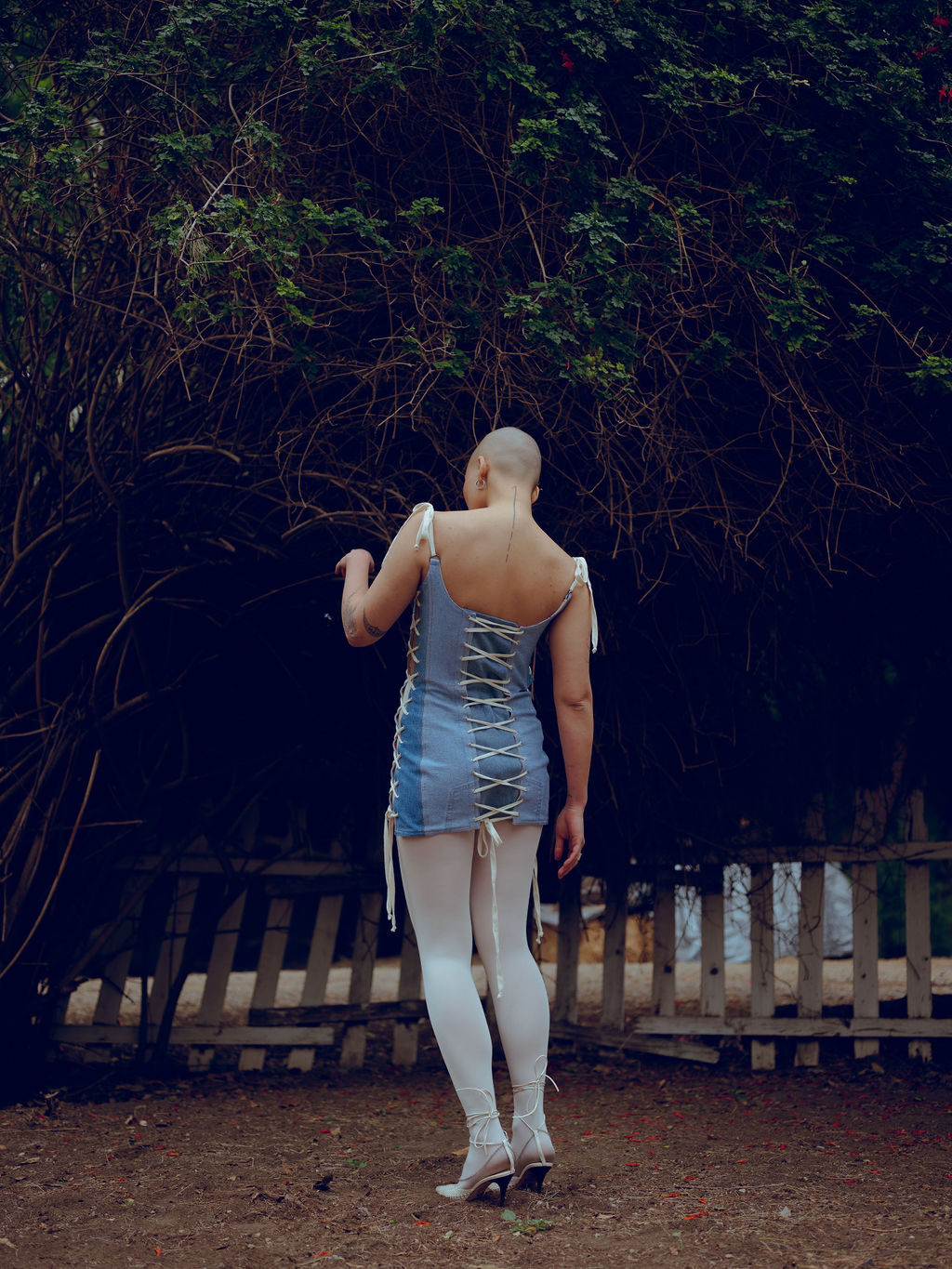
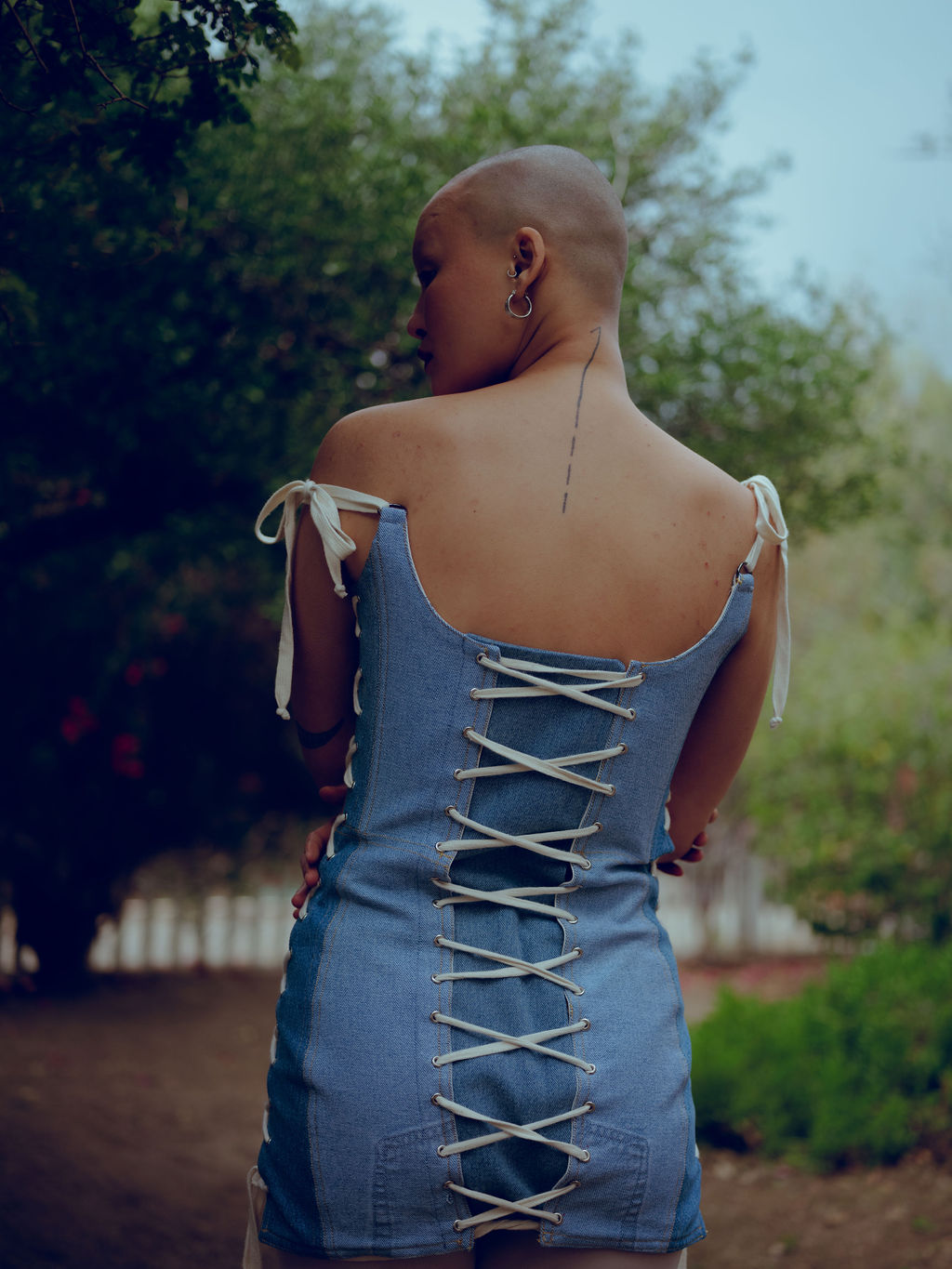
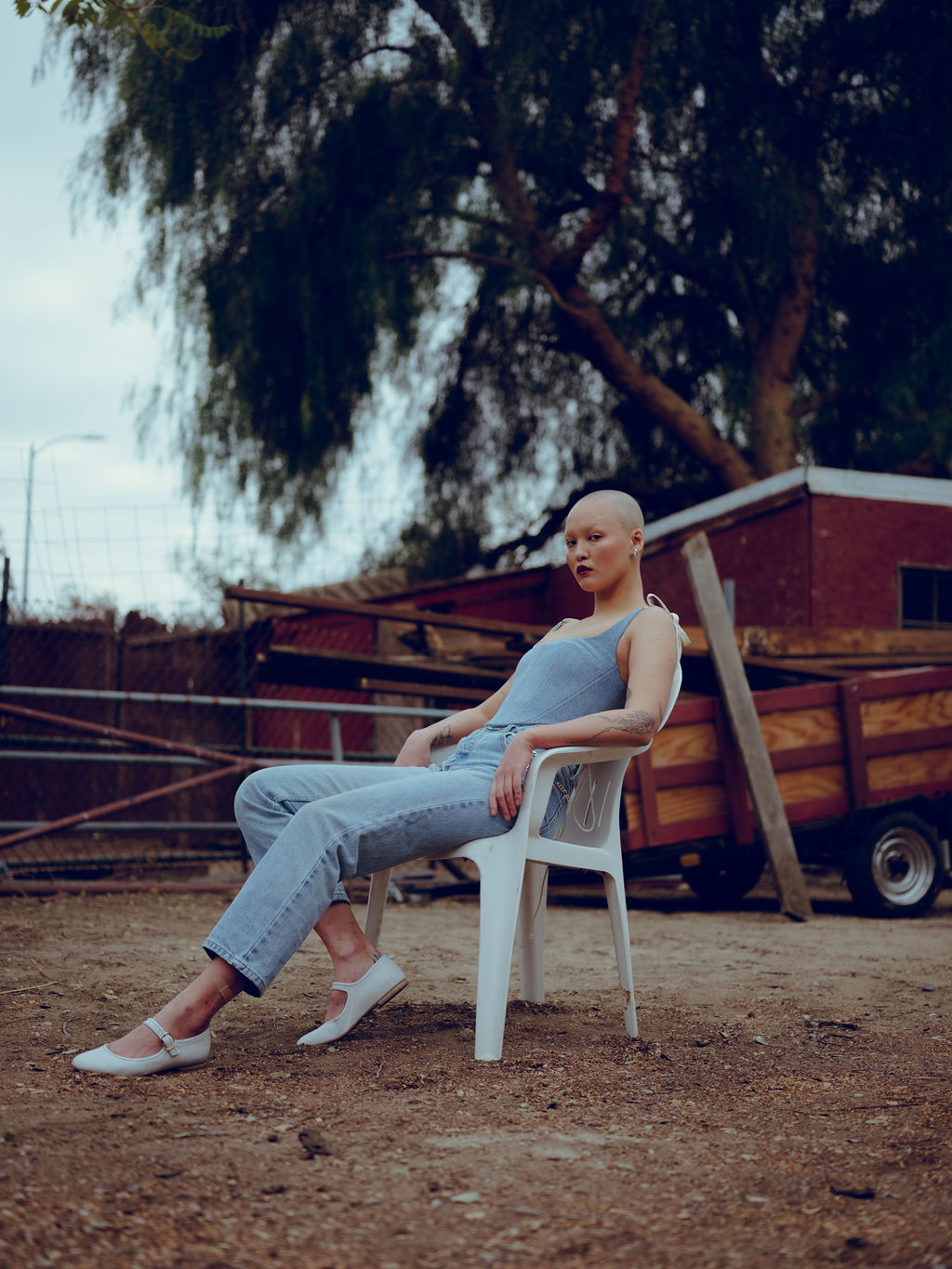
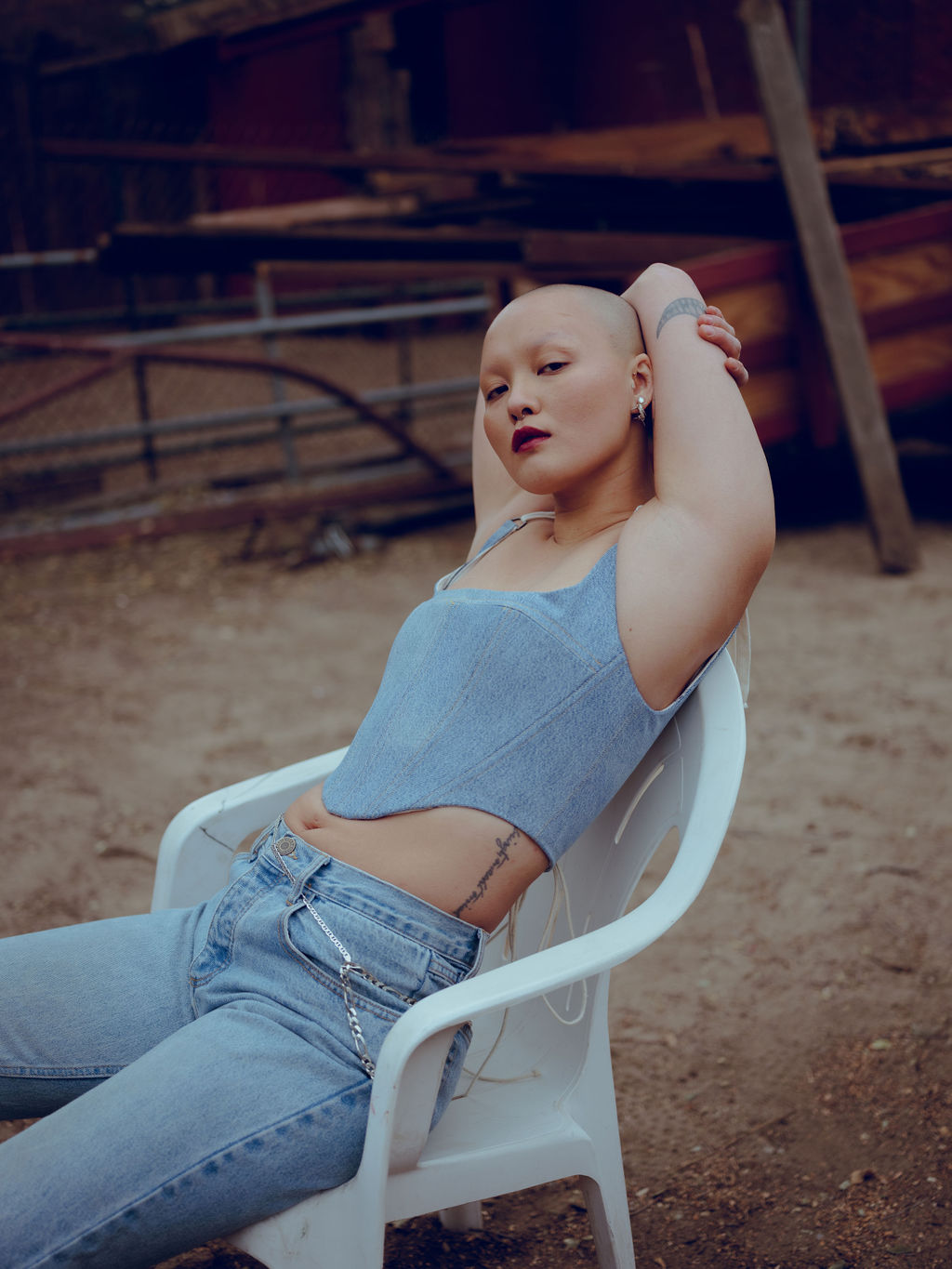
Kayla Sade has always been interested in creative ways to make her life sustainable. While attending an environmentally-focused charter high school in Wisconsin, she worked in their urban garden and began thrifting and upcycling clothing. After college, she taught herself how to sew, via internet videos and a few classes on the fundamentals. Soon, Sade was reworking thrifted pieces, photographing them, and selling them on Etsy.
Fast forward to 2020 and Sade, who now lives in San Francisco, found herself at home with downtime to revisit these teen passions. She decided to transform thrifted Nike sweats and Budweiser towels into corsets, which she sold on Depop. Within three months of her launch, she’d gained 31,000 followers on Instagram; now, devoted fans set alerts, in hopes they don’t miss her next drop.
Sade calls her project Almost on Time. “It’s a word play on being fashionably late and also a call to stop the frantic cycle that is fast fashion,” she explains. “I give new life to old garments, literally making them into [stylish pieces] at a later point in time.”
The work also served as a balm during difficult times, especially during the height of the Black Lives Matter protests. “Literally waking up everyday to learn of another Black person being killed unjustly, or [seeing] more police brutality from the past being unearthed is a very traumatic experience. I am just glad to have sewing and design as a creative outlet and escape from the real world," she told Fashionista in July 2020.
When presented with her box of denim, Sade knew instantly she had to make something corseted. “[Corsets are] my signature and I started making them with upcycled materials because you use many small panels, which is perfect for getting creative with scraps,” she says. Sade cut and sewed the piece using a pre-existing pattern, adding boning and laces to give it structure. “I try to showcase the beauty of found materials, regardless of the condition or type of material it is,” Sade says. “I typically don’t dye or manipulate [anything].”
Almost on Time is an ever-evolving project that Sade hopes will inspire others to upcycle items into works of art. “The beauty is in the journey of finding things others have discarded and deemed useless, deconstructing, learning along the way,” she says. Sounds like timely advice.
Rentrayage: A Modern Dress Using Classic Techniques
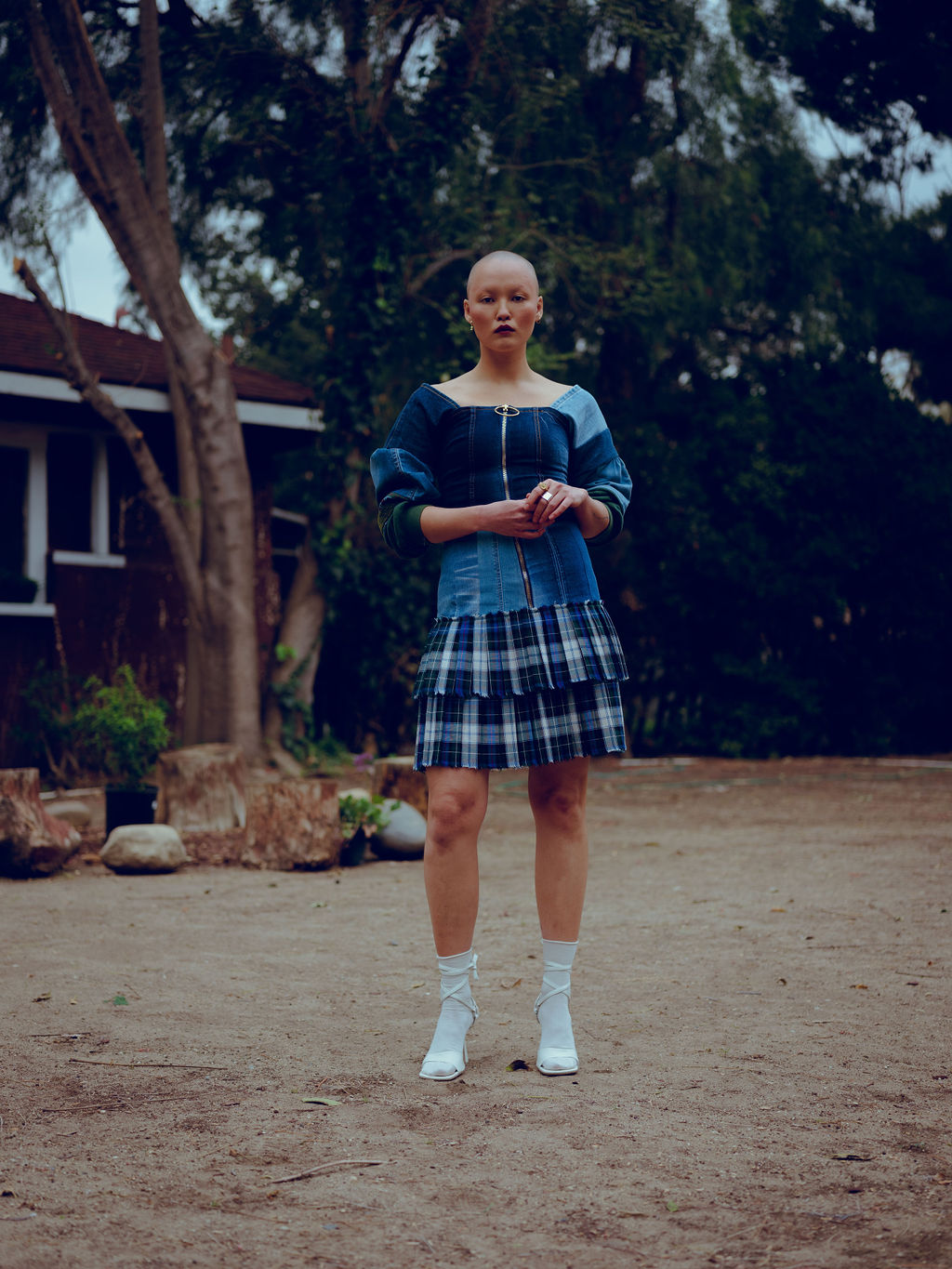
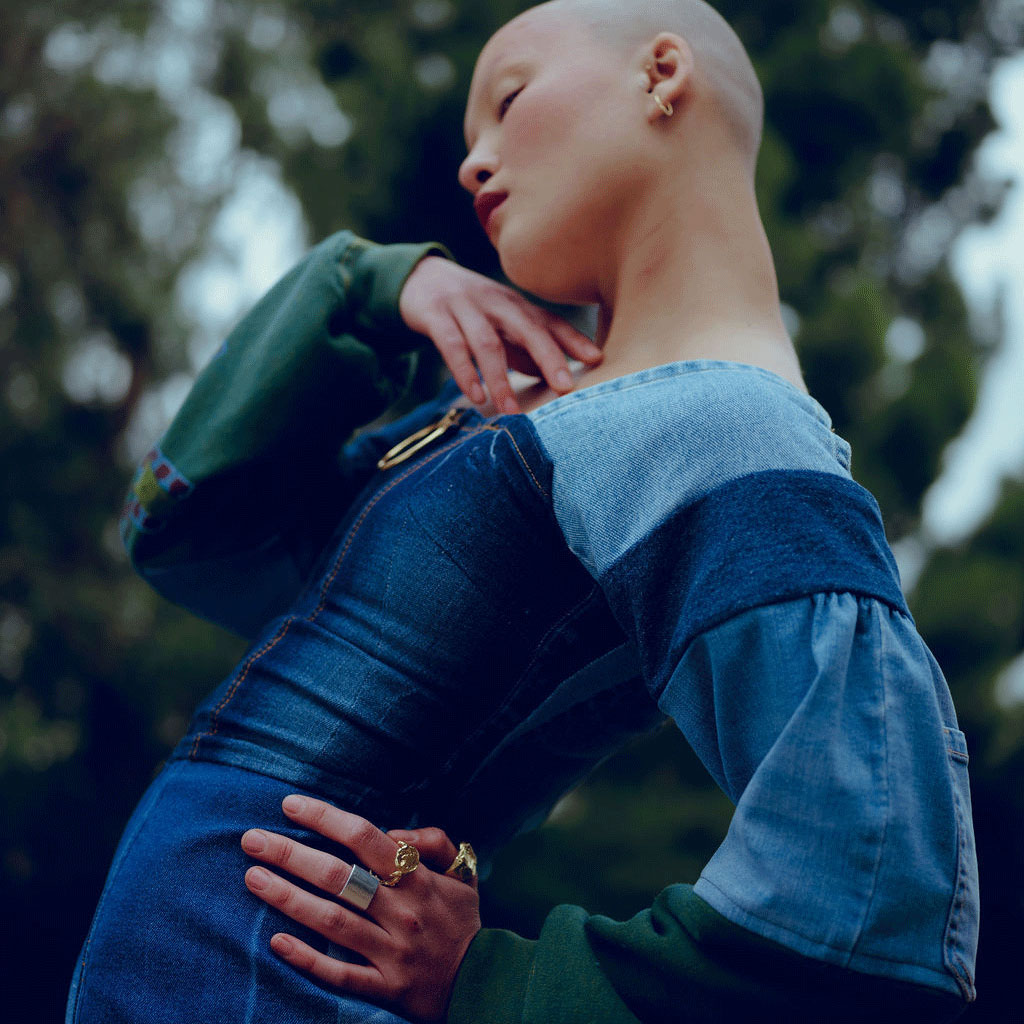
You may know Erin Beatty from the socially responsible luxury label Suno that she launched with Max Osterweis in 2008. After Suno shut its doors in 2016, Beatty worked as a consultant before launching Rentrayage three years later. With a mission to rethink how clothing can be made, Rentrayage features handmade pieces that use vintage and deadstock materials in modern silhouettes.
For this challenge Beatty decided to combine denim with a vintage sweatshirt and deadstock plaid fabric that she had leftover from a previous fall season. “I was inspired to make something that fit into what I was making for our upcoming season. We’re playing with fitted bodices and this shape felt appropriate,” she says of the dress she created in tandem with the brand’s tailor, Albert Torres.
As for the process, Beatty relied on classic techniques. “It’s just good, old-fashioned draping. [Torres and I] go back and forth, him speaking through draping, me through sketches.”
The ultimate creation is a unique mismatched long sleeve dress with a pleated wool skirt. It’s kind of grunge-y, kind of schoolgirl, and definitely not something you’d ever find at a fast fashion retailer. Pieces like this are precisely why Beatty started Rentrayage, “It’s amazing what levels of creativity you can achieve with this method of designing,” she says. “This method is a win-win: a one-of-a-kind piece that adds nothing new to the environment.”
Photographer: Kanya Iwana | Model: Ad Mur at Photogenics | Stylist: Kat Typaldos | Makeup: Dana Delaney at The Wall Group| Production: David Lipford at Dual Phocus
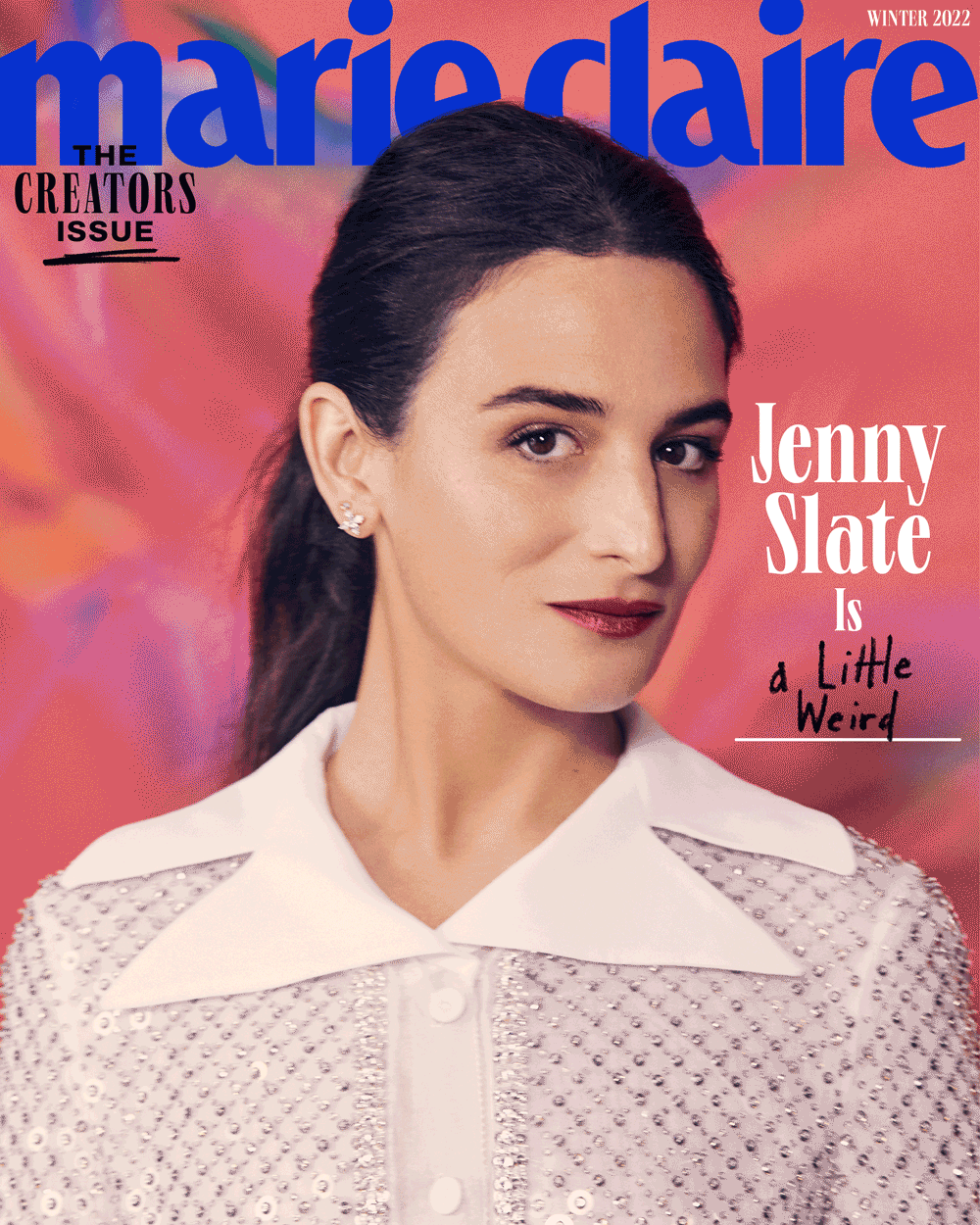
Click here to read the full Creators Issue.
Letter From the Editor
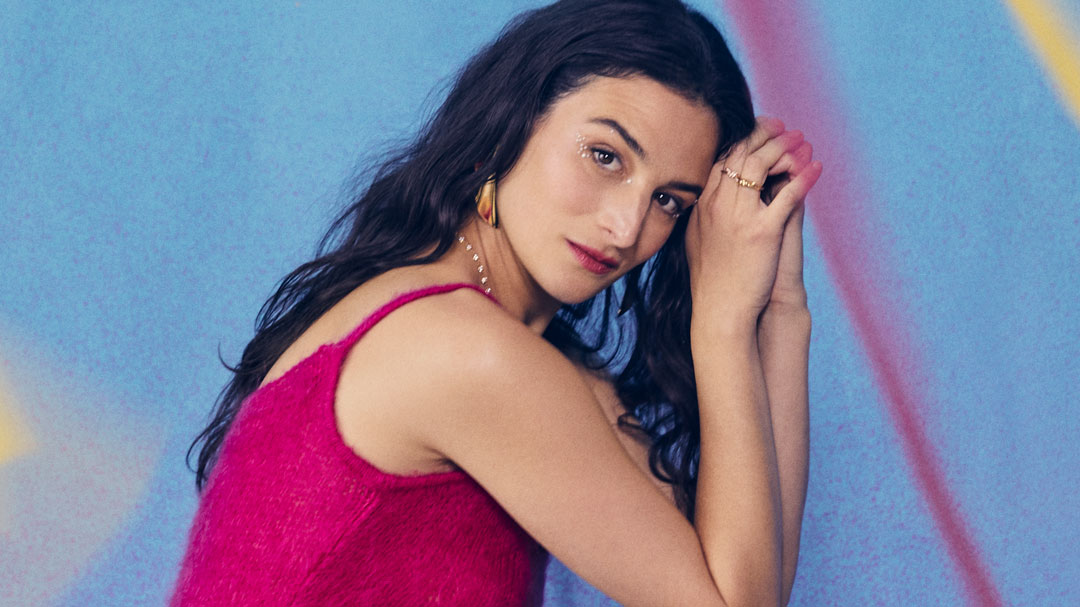
-
 Princess Anne's Unexpected Suggestion About Mike Tindall's Nose
Princess Anne's Unexpected Suggestion About Mike Tindall's Nose"Princess Anne asked me if I'd have the surgery."
By Amy Mackelden Published
-
 Queen Elizabeth's "Disapproving" Royal Wedding Comment
Queen Elizabeth's "Disapproving" Royal Wedding CommentShe reportedly had lots of nice things to say, too.
By Amy Mackelden Published
-
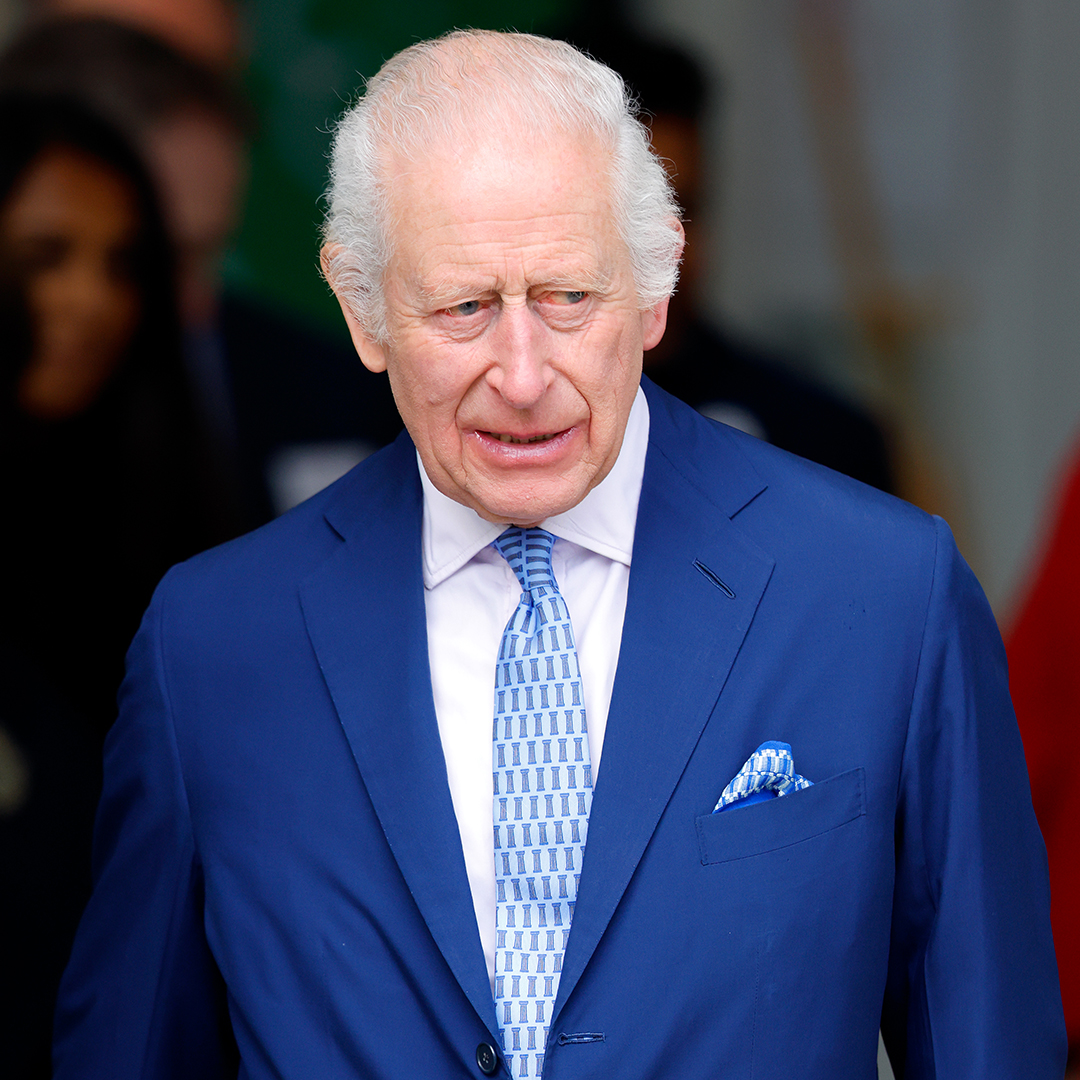 Palace Employees "Tried" to Get King Charles to "Slow Down"
Palace Employees "Tried" to Get King Charles to "Slow Down""Now he wants to do more and more and more. That's the problem."
By Amy Mackelden Published
-
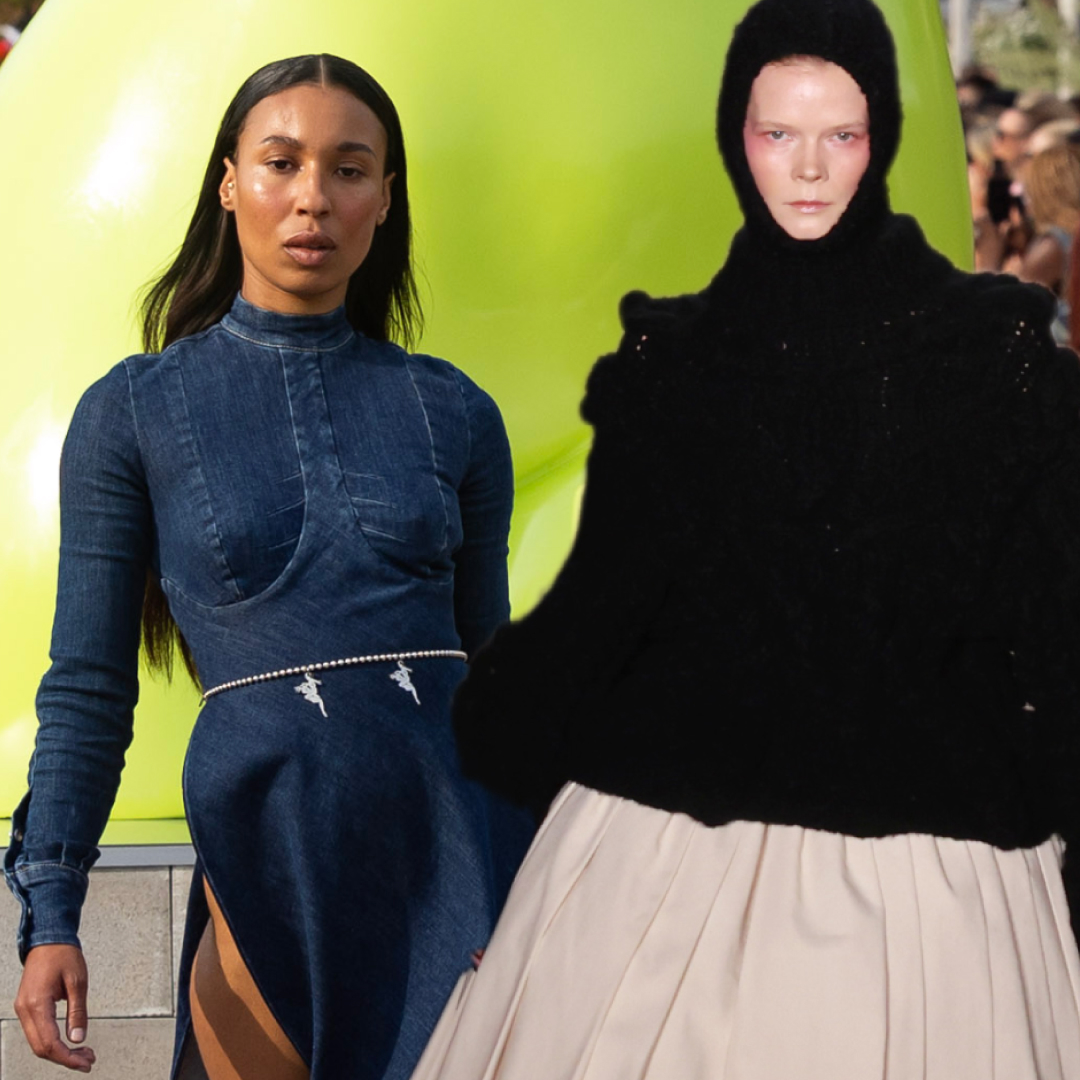 The 2025 LVMH Prize Semifinalists Suggest Inclusive Design Is Worth the Investment
The 2025 LVMH Prize Semifinalists Suggest Inclusive Design Is Worth the InvestmentThe 2025 LVMH Prize Semifinalists are a sign of fashion's forward-thinking future.
By Halie LeSavage Published
-
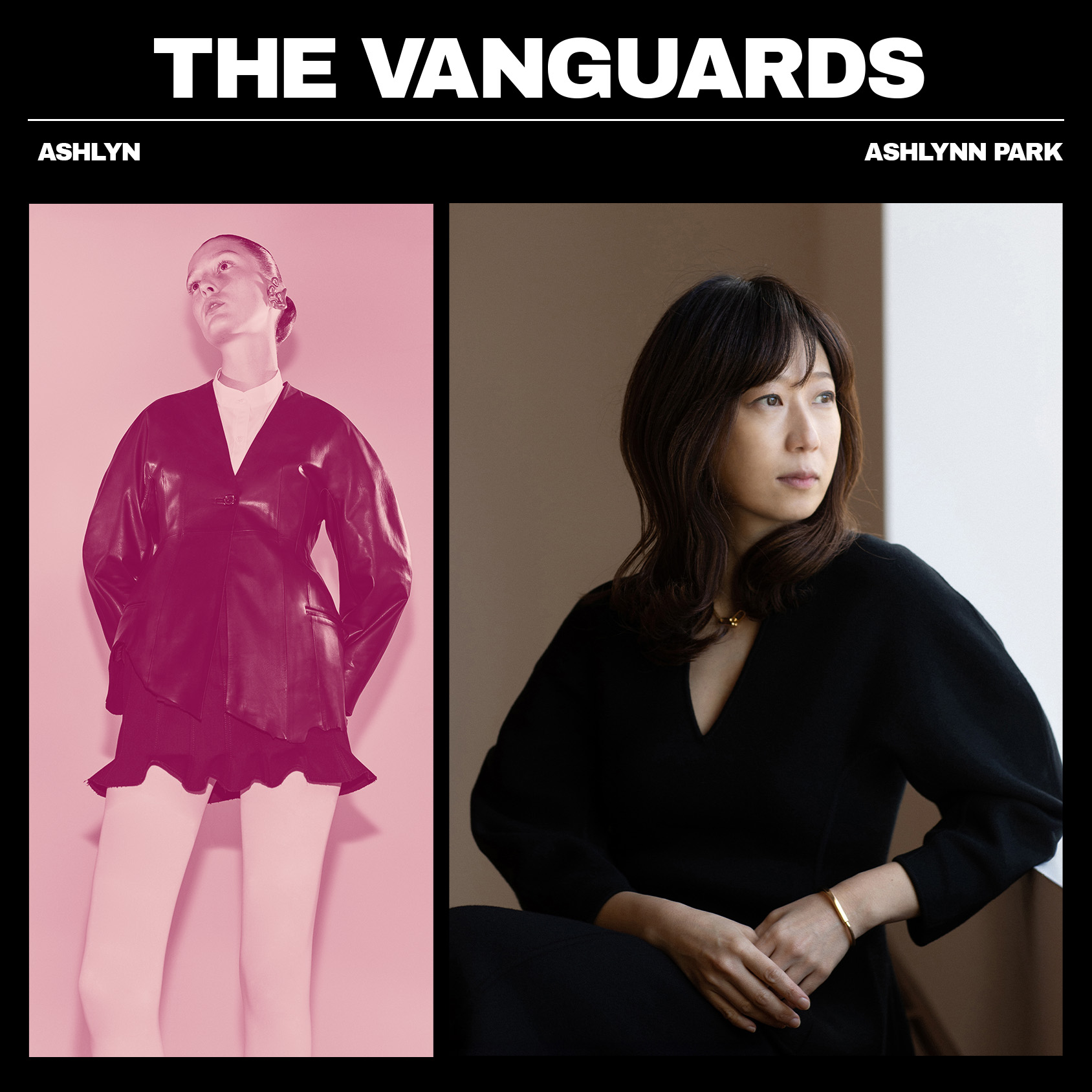 Designer Ashlynn Park Learned From Fashion Legends—Now, She's Forging Her Own Legacy
Designer Ashlynn Park Learned From Fashion Legends—Now, She's Forging Her Own LegacyWith mentors like Issey Miyake and Yohji Yamamoto, Park has become an expert at creating beautiful shapes from scratch.
By Emma Childs Published
-
 Truman Capote Had His Swans—Now Christopher John Rogers Has His Squirrels
Truman Capote Had His Swans—Now Christopher John Rogers Has His SquirrelsAs the designer prepares for his much-anticipated runway show at New York Fashion Week, we tap into the vibrant cult following that fuels his rainbow-colored world.
By Emma Childs Published
-
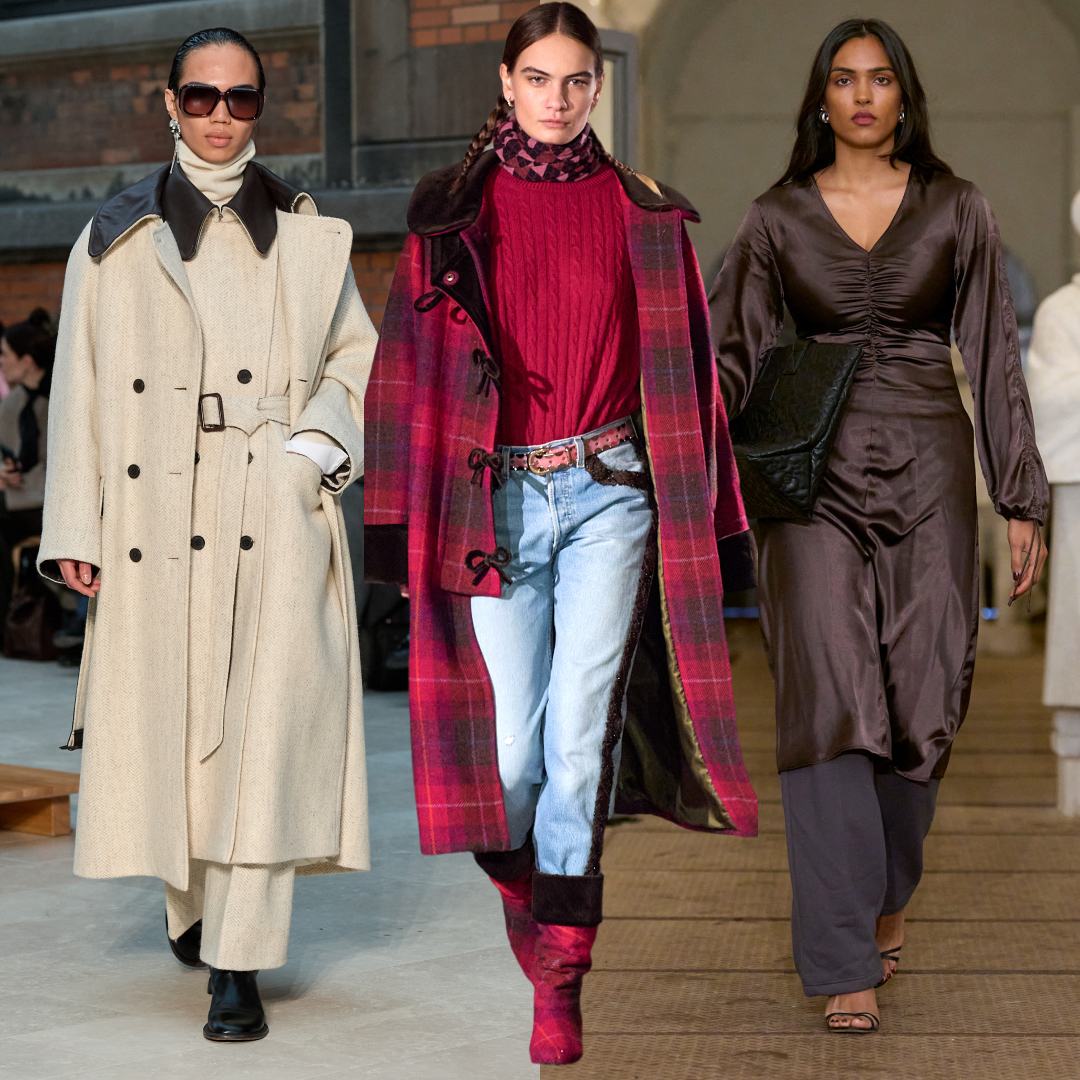 Copenhagen Fashion Week's Best Fall 2025 Collections Say Sustainable Design Isn't a Compromise
Copenhagen Fashion Week's Best Fall 2025 Collections Say Sustainable Design Isn't a CompromiseCopenhagen Fashion Week's Fall 2025 runways reminded guests that eco-conscious design can also be fun.
By Halie LeSavage Published
-
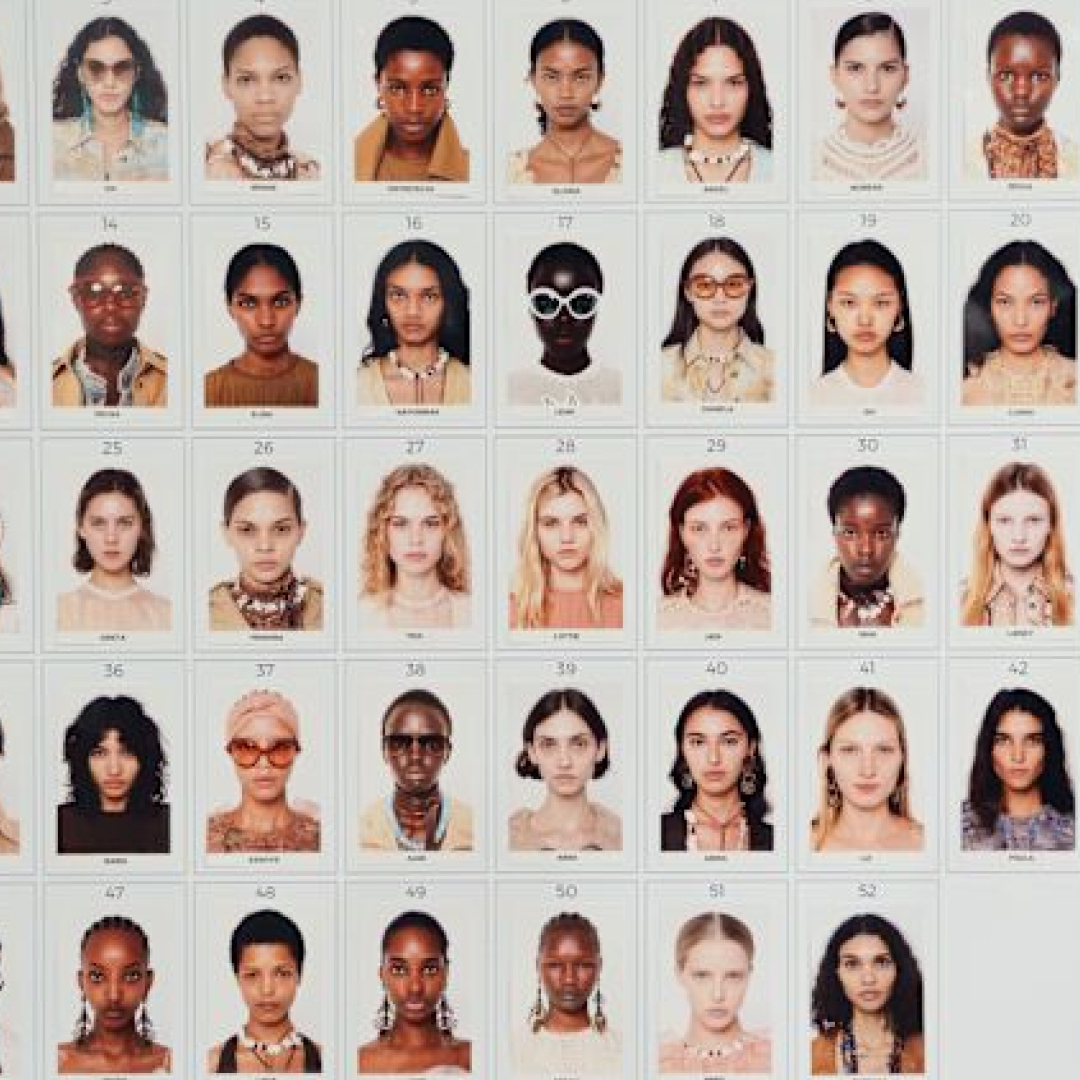 Where Did All the Size-Inclusive Fashion Go?
Where Did All the Size-Inclusive Fashion Go?Spring 2025's runways glorified thinness to a troubling degree.
By Halie LeSavage Published
-
 New York Fashion Week's Best Spring 2025 Looks Redefine Real Clothes
New York Fashion Week's Best Spring 2025 Looks Redefine Real ClothesKallmeyer, Rachel Comey, and Maria McManus define a new kind of everyday aspiration.
By Halie LeSavage Published
-
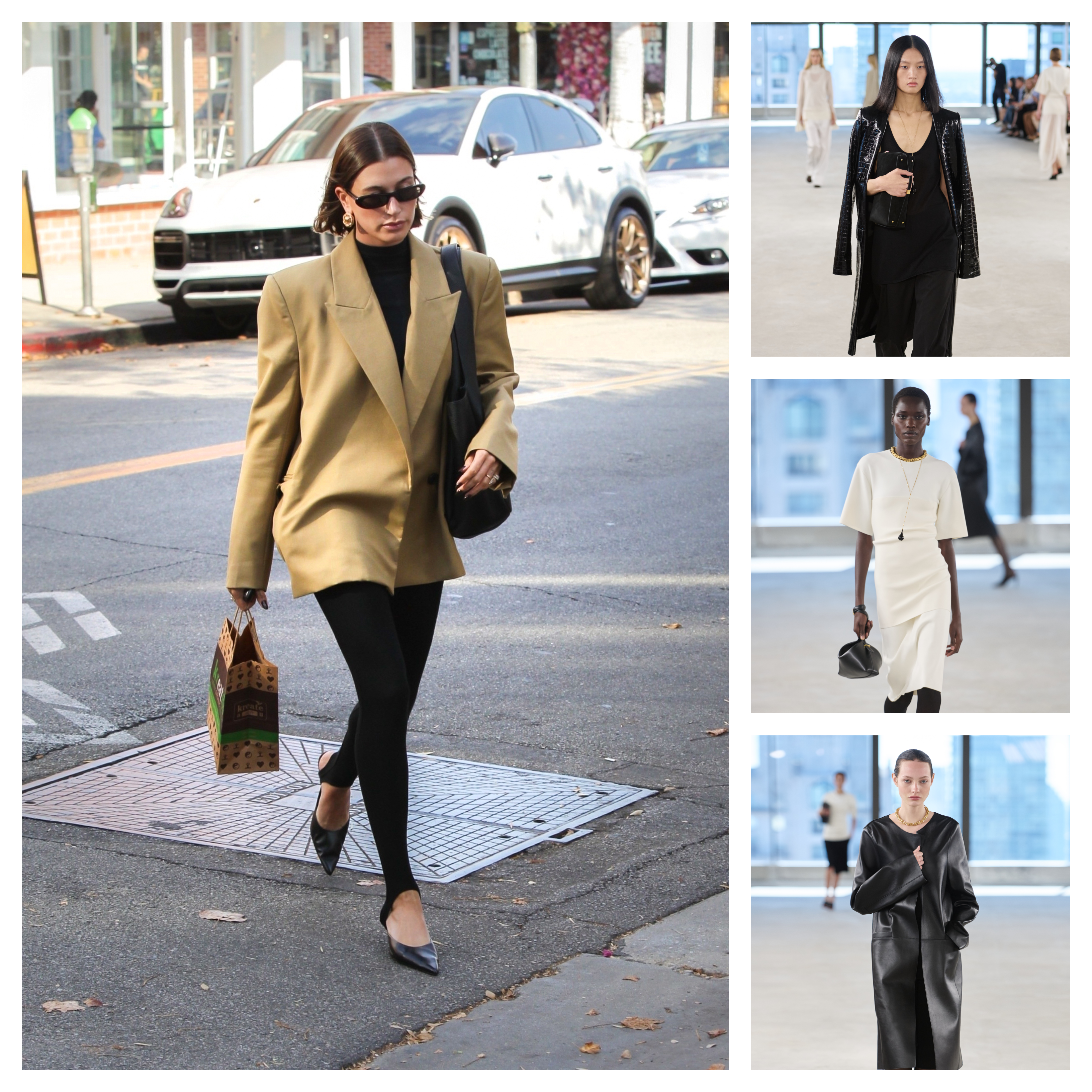 What Does Toteme Clothing Have That Other Minimalist Brands Don't?
What Does Toteme Clothing Have That Other Minimalist Brands Don't?The label positively took over New York Fashion Week.
By Halie LeSavage Last updated
-
 First Jamie Haller's Shoes Captivated Tastemakers. Now She's Taking Over Their Entire Closets
First Jamie Haller's Shoes Captivated Tastemakers. Now She's Taking Over Their Entire ClosetsJamie Haller's first clothing line is available today.
By Halie LeSavage Published